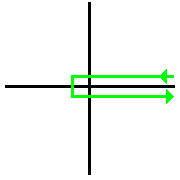

In mathematics, a Hankel contour is a path in the complex plane which extends from (+∞,δ), around the origin counter clockwise and back to (+∞,−δ), where δ is an arbitrarily small positive number. The contour thus remains arbitrarily close to the real axis but without crossing the real axis except for negative values of x. The Hankel contour can also be represented by a path that has mirror images just above and below the real axis, connected to a circle of radius ε, centered at the origin, where ε is an arbitrarily small number. The two linear portions of the contour are said to be a distance of δ from the real axis. Thus, the total distance between the linear portions of the contour is 2δ. The contour is traversed in the positively-oriented sense, meaning that the circle around the origin is traversed counter-clockwise.
Use of Hankel contours is one of the methods of contour integration. This type of path for contour integrals was first used by Hermann Hankel in his investigations of the Gamma function.
The Hankel contour is used to evaluate integrals such as the Gamma function, the Riemann zeta function, and other Hankel functions (which are Bessel functions of the third kind).
Applications
The Hankel contour and the Gamma function
The Hankel contour is helpful in expressing and solving the Gamma function in the complex t-plane. The Gamma function can be defined for any complex value in the plane if we evaluate the integral along the Hankel contour. The Hankel contour is especially useful for expressing the Gamma function for any complex value because the end points of the contour vanish, and thus allows the fundamental property of the Gamma function to be satisfied, which states .
Derivation of the contour integral expression of the Gamma function
The Hankel contour can be used to help derive an expression for the Gamma function, based on the fundamental property . Assume an ansatz of the form , where is the Hankel contour.
Inserting this ansatz into the fundamental property and integrating by parts on the right-hand side, one obtains
Thus, assuming decays sufficiently quickly such that vanishes at the endpoints of the Hankel contour,
The solution to this differential equation is While is a constant with respect to , may nonetheless be a function of . Substituting into the original integral then gives where the minus sign in is accounted for by absorbing a factor into the definition of .
By integrating along the Hankel contour, the contour integral expression of the Gamma function becomes .
References
- ^ Krantz, Steven G. (Steven George), 1951- (1999). Handbook of complex variables. Boston, Mass.: Birkhäuser. ISBN 0-8176-4011-8. OCLC 40964730.
{{cite book}}: CS1 maint: multiple names: authors list (link) CS1 maint: numeric names: authors list (link) - ^ Moretti, Gino (1964). Functions of a Complex Variable. Englewood Cliffs, N.J.: Prentice-Hall, Inc. pp. 179–184. LCCN 64012240.
Further reading
- Schmelzer, Thomas; Trefethen, Lloyd N. (2007-01). "Computing the Gamma Function Using Contour Integrals and Rational Approximations". SIAM Journal on Numerical Analysis. 45 (2): 558–571. doi:10.1137/050646342. ISSN 0036-1429.
- Hugh L. Montgomery; Robert C. Vaughan (2007). Multiplicative number theory I. Classical theory. Cambridge tracts in advanced mathematics. 97. p. 515. ISBN 0-521-84903-9.
External links
- http://mathworld.wolfram.com/HankelContour.html
- NIST Digital Library of Mathematical Functions:Gamma Function:Integral Representation
 .
.
 , where
, where  is the Hankel contour.
is the Hankel contour.

 decays sufficiently quickly such that
decays sufficiently quickly such that  vanishes at the endpoints of the Hankel contour,
vanishes at the endpoints of the Hankel contour,

 While
While  is a constant with respect to
is a constant with respect to  ,
,  .
Substituting
.
Substituting  where the minus sign in
where the minus sign in  is accounted for by absorbing a factor
is accounted for by absorbing a factor  into the definition of
into the definition of  .
.
 .
.